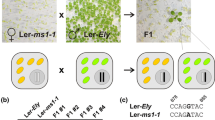Summary
Up to now Antirrhinum was classified as a typical example for a uniparentalmaternal inheritance of the plastids. However, the findings reported here prove that also the male gametophyte of Antirrhinum may occasionally transmit plastids into the egg. This conclusion is based on genetic experiments involving a form of the plastom mutant “prasinizans” which is described as “gelbgrüne prasinizans”. In contrast to all other plastid mutations known in Antirrhinum majus this mutant originated in “Sippe 50” is completely viable. In plants containing plastids of this mutant type only, the mutant character is manifested during early growth stages. Cotyledons and first foliage leaves which are initially white or white yellow, slowly turn green and become indistinguishable from normal “Sippe 50”. Reciprocal crosses of green “Sippe 50” with “gelbgrüne prasinizans” gave few variegated descendants; the others were exclusively plants identical with the maternal parent as far as leaf colour is concerned (Table). The variegated individuals cannot be gene mutants since selfing and crossing experiments showed non-mendelian inheritance. Furthermore it could be ruled out that in the cross Sippe 50 ♀ x gelbgrüne prasinizans ♂ the three variegated descendants represent spontaneous new plastom mutants because the pale tissue in these plants turned green in the same way as the paternal parent. Because of the typical greening of this mutant and since plastid mutations could be ruled out we have to conclude that plastids were transmitted by the pollen parent into the egg. There these plastids multiplied together with the maternal plastids giving rise to the chimeras after sorting-out of the two plastid types. This interpretation is supported by the observation of mixed cells in tissues where the leaf variegation is finely mosaiced. The results were possible only because the plastids of the pollen parent can be unequivocally recognised.
Similar content being viewed by others
Literatur
Baur, E.: Das Wesen und die Erblichkeitsverhältnisse der “Varietates albomarginatae hort.” von Pelargonium zonale. Z. indukt. Abstamm.- u. Vererb.-L. 1, 330–351 (1909)
—: Vererbungs- und Bastardierungsversuche mit Antirrhinum. Z. indukt. Abstamm.- u. Vererb.-L. 3, 34–98 (1910).
—: Untersuchungen über die Vererbung von Chromatophorenmerkmalen bei Melandrium, Antirrhinum und Aquilegia. Z. indukt. Abstamm. u. Vererb.-L. 4, 81–102 (1910/11).
—: Linführung in die Vererbungslehre, 7-11. Aufl. Berlin: Gebrüder Borntraeger 1930.
Correns, C., u. F. v. Wettstein: Nicht mendelnde Vererbung. In: Handbuch der Vererbungswissenschaft, Bd. II H. Berlin: Gebrüder Borntraeger 1937.
Gairdnee, A. E., and J. B. S. Haldane: A case of balanced lethal factors in Antirrhinum majus. J. Genet. 21, 315–325 (1929).
Hagemann, R.: Das Vorkommen von Mischzellen bei einer Gaterslebener Herkunft des Status albomaculatus von Antirrhinum majus L. Kulturpfl. 8, 168–184 (1960).
—: Plasmatische Vererbung. Jena: Gustav Fischer 1964.
Kirk, J. T. O., and R. A. E. Tilney-Bassett: The plastids; Their chemistry, structure, growth and inheritance. London and San francisco: Freeman & Co. 1967.
Maly, R.: Die Mutabilität der Plastiden von Antirrhinum majus L. Sippe 50. Z. Vererbungsl. 89, 692–696 (1958).
—, u. A. Wild: Ein cytologischer Beitrag zur “Entmischungstheorie” verschiedener Plastidensorten. Z. Vererbungsl. 87, 493–496 (1956).
Michaelis, P.: Über die Vererbung von Plastidenmerkmalen. Protoplasma (Wien) 48, 403–418 (1957).
—: Untersuchungen zur Mutation plasmatischer Erbträger, besonders der Plastiden II. Planta (Berl.) 51, 722–756 (1958).
—: Virus und zytoplasmatische Vererbung. Z. Pflanzenzüchtg. 52, 333–354 (1964).
Radunz, A.: Über das Vorkommen von verzweigtkettigen Fettsäuren bei Antirrhinum majus. Hoppe-Seylers Z. physiol. Chem. 341, 192–203 (1965).
—: Chlorophyll- und Lipidgehalt der Blätter und Chloroplasten von Antirrhinum majus in Abhängigkeit von der Entwicklung. Z. Pflanzenphysiol. 54, 395–406 (1966a).
—: Über die Fettsäuren in Blättern und Chloroplasten von Antirrhinum majus in Abhängigkeit von der Entwicklung. Flora (Jena), Abt. A, 157, 131–160 (1966b).
Renner, O.: Zur Kenntnis der nichtmendelnden Buntheit der Laubblätter. Flora (Jena) 130, 218–290 (1936).
Scherz, W.: Belträge zur Genetik der Buntblättrigkeit. Z. indukt. Abstamm.-u. Vererb.-L. 45, 1–40 (1927).
Weber, P.: Über lamellare Strukturproteide aus Chloroplasten verschiedener Pflanzen. Z. Naturforsch. 17b, 683–688 (1962).
Wild, A.: Untersuchungen zweier albomakulater Linien von Antirrhinum majus auf ihr Verhalten in Teilreaktionen der Photosynthese. Beitr. Biol. Pflanzen 35, 137–175 (1959).
Author information
Authors and Affiliations
Rights and permissions
About this article
Cite this article
Diers, L. Übertragung von Plastiden durch den Pollen bei Antirrhinum majus . Molec. Gen. Genet. 100, 56–62 (1967). https://doi.org/10.1007/BF00425775
Received:
Issue Date:
DOI: https://doi.org/10.1007/BF00425775




